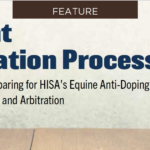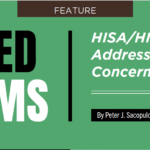Taking the proper precautions can help reduce your liability for an equine-related website
By Peter J. Sacopulos, JD
As the economy tightens and competition becomes more intense, establishing and maintaining a website or other online presence has become a matter of business necessity. Yet, despite its unquestionable advantages, the formation and operation of an equine website exposes its owner(s) or operator(s), whether horse owners, trainers, breeders, farms or retailers, to potential new areas of liability. There are several major areas of potential liability associated with the formation, operation and maintenance of a website, but there are methods to assist the equine business professional in minimizing those risks. While this article focuses specifically on websites, the same general principles can also apply to other forms of online activity, such as a Facebook page, Twitter account or a user-created profile page on a website like OwnerView.com.
Infringement Issues
The first area of potential liability involves infringement issues. Two main areas of infringement are domain name and the content of the website, specifically involving copyright issues.
Typically, the first step in the creation of any website is registration of a domain name with the appropriate registrar. A domain name registrar is a company or entity accredited either by the Internet Corporation for Assignment of Names and Numbers (ICANN) or by a national authority, or both. Upon applying to register for a domain name, the applicant may well find that the desired name, such as jonesstudstation.com or springvalleyranch.com, is already registered to another equine person, business or entity. The registrar will inform the applicant whether the desired domain name is or is not available.
Additionally, the registrar may advise that the requested domain name is similar or too similar to a currently registered name. If this is the case, the question one must ask is whether a reasonable person conducting a search can become confused or mislead by the similarities. If the answer is yes, it is advised to select an alternate domain name to avoid potential conflict and liability related to the persons business or entity in possession of the previous registered domain name.
The second major area of infringement involves the content of the equine website and specifically the liability associated with copyright infringement. The equine business owner/professional must be certain that the content of the equine website, including text and images (photographs), are not copyright protected. Several laws, including the Digital Millennium Copyright Act (DMCA) of 1998, prohibit the reproduction, distribution or public display of copyrighted materials on the Internet without the permission of the copyright holder. There are, however, exceptions including the “fair use” exception as well as other recognized statutory exceptions.
One exception to the federal laws protecting copyrighted material pertains to websites that have certain features such as bulletin boards. Some such sites permit users to post and exchange articles, information, photographs, videos and other such material. In these cases, the DMCA limits a website owner’s liability for user-committed copyright infringements if the owner of the website has adopted certain procedures. For example, one of the adopted procedures must include a provision in the website user agreement stating that repeat copyright infringers will be terminated, and the website must also accommodate standard technical measures used by copyright owners to identify and protect their copyrighted works. Additionally, the website must promptly remove any infringing material when notified of the infringement by the copyright holder. That procedure is commonly referred to as the “notice and take down” procedure.
Privacy Issues
A second area of potential liability for those establishing, operating and/or maintaining an equine website is privacy issues. For example, businesses that provide breeding and foaling services often obtain personal information from visitors to their website. This information may include names, e-mail addresses, mailing addresses, telephone numbers, biological information, demographic information and financial information. If this type of information is requested or collected and maintained by the equine facility or professional operating the equine website, steps must be taken to safeguard such personal information. In fact, equine professionals planning to create and maintain a website or that are presently operating a website should be aware that there are privacy and security concerns that may implicate federal and state statutes. The major federal statutes are the Computer Fraud and Abuse Act, the Federal Wire Tap Act, the Electronic Communication Privacy Act, the Gramm-Leach-Biley Act and the Health Insurance Portability and Accountability Act. Various states also have statutes that require those operating a website and collecting such personal information to conspicuously post a privacy policy informing and advising visitors of: (1) the categories of personal information collected and the third parties with whom that information may be shared; (2) the process for reviewing and requesting changes to collected information; (3) the process by which the operator of the website notifies users or visitors regarding material changes to the existing privacy policy; and (4) the effective date of the privacy policy.
Some stables have youth programs such as pony clubs. Privacy concerns about children impose additional areas of potential liability for equine professionals utilizing a website to promote any equine business or program targeting children under the age of 13. In fact, Congress has enacted special privacy protection for children under the age of 13. It is unlawful for the owner or operator of a website or online service directed at children or any operator that has actual knowledge that information is being collected from a child to collect personal information from a child in a manner that violates strict statutory-mandated regulation. Those federal statutory regulations are contained in the Child Online Protection Act of 1998 and are enforced by the FTC. In short, it is very important for the equine professional that utilizes and promotes his or her business by way of a website to strictly comply with privacy requirements as violations pertaining to children can carry both civil and criminal penalties.
An additional area of concern for the equine professional is the potential liability to another for invasion of his or her privacy. For example, a famous jockey’s or trainer’s name or likeness cannot be used by the owner or operator of an equine website for the user’s or owner’s own benefit without permission. The best method of avoiding the potential for liability based on invasion of privacy is to obtain written permission before using another’s name or image on an equine website.
Other Liability
As a general rule, the owner or operator of a website is subject to the same principles of liability for defamation as is a speaker or author publishing defamatory statements through any other medium. However, Congress has created a safe harbor for the owner or operator of a website that allows viewers to post messages and information and/or interact with one another. In such cases, the Federal Communications Decency Act of 1996 states: “No provider or user of an interactive computer service shall be treated as the publisher or speaker of any information provided by another information content provider.” Aside from this exception, the owner/operator of an equine website faces potential liability for defamatory postings.
Information posted on equine websites on how to blister a leg, how to load a yearling into a horse trailer or how to train a 2-year-old to break faster from the gate all constitute instructional information and potential liability to a website viewer who is damaged by relying on that information or those instructions. Reliance issues and corresponding liability require the equine professional to prominently post a disclaimer of liability for any harm, economic or otherwise, that may be suffered by a website user or viewer or others from the user or viewer’s use of the website. Such a disclaimer may be included in a user agreement that must be acknowledged before access is granted to the website or posted on the website separately. An example for an equine website is: “The information provided on Green Gables Stud website has been compiled for your convenience. Green Gables Stud makes no warranties about its reliability, accuracy or completeness for any information contained on Green Gables’ website.”
The above-stated concerns are also relevant to links to other websites, which are often referred to as hyperlinks. As such, an appropriate disclaimer relative to the accuracy of information contained on any linked websites should also be prominently posted or displayed on the equine professional’s website. An example of a disclaimer relative to a hyperlink is: “Before using other websites or disclosing personal information to them, Green Gables Stud suggests that you examine the terms and conditions of those websites, as they may be different from Green Gables’ website.”
Websites for any business, including equine businesses, bring certain risks of liability. However, these risks can be minimized through careful attention to issues of infringement, privacy, defamation, reliance and accessibility, which will then allow the benefits of maintaining an equine website to be enjoyed and the owner’s and operator’s business to be greatly expanded.
Peter Sacopulos owns and operates Green Gables Stud in Clay County, Indiana. In addition, Peter Sacopulos is an attorney practicing equine law with the firm Sacopulos, Johnson & Sacopulos in Terre Haute, Indiana. Peter may be reached at pete_sacopulos@sacopulos.com.




